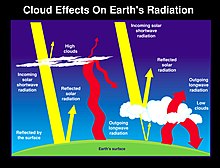
Back بياض السحاب Arabic Albedo de nube Spanish Skyalbedo NN Skyalbedo NB மேக எதிரொளிப்புத்திறன் Tamil

Cloud albedo is a measure of the albedo or reflectivity of a cloud. Clouds regulate the amount of solar radiation absorbed by a planet and its solar surface irradiance. Generally, increased cloud cover correlates to a higher albedo and a lower absorption of solar energy. Cloud albedo strongly influences the Earth's energy budget, accounting for approximately half of Earth's albedo.[1][2] Cloud albedo is influenced by the conditions of cloud formation and variations in cloud albedo depend on the total mass of water, the size and shape of the droplets or particles and their distribution in space.[3] Thick clouds reflect a large amount of incoming solar radiation, translating to a high albedo. Thin clouds tend to transmit more solar radiation and, therefore, have a low albedo. Changes in cloud albedo caused by variations in cloud properties have a significant effect on global climate, having the ability to spiral into feedback loops.[3]
- ^ Cite error: The named reference
:1was invoked but never defined (see the help page). - ^ Mueller, Richard; Trentmann, Jörg; Träger-Chatterjee, Christine; Posselt, Rebekka; Stöckli, Reto (2011). "The Role of the Effective Cloud Albedo for Climate Monitoring and Analysis". Remote Sensing. 3 (11): 2305–2320. Bibcode:2011RemS....3.2305M. doi:10.3390/rs3112305. ISSN 2072-4292.
- ^ a b Hartmann, Dennis (2016). Global Physical Climatology. Australia: Elsevier. pp. 76–78. ISBN 978-0-12-328531-7.